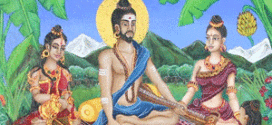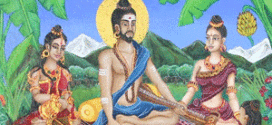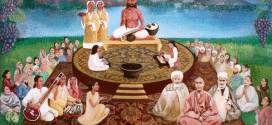Abhinavagupta is considered the greatest exegetical theologian of the Shaiva tradition in the medieval period. A prolific and polymath writer, he is credited with the authorship of as manyas fifty works, only some of which survive to the present day. The two most important philosophical writings were the Parâtrimshikâ-Vivarana and the Tantraloka. Parmarthsara, a philosophical composition of 105 verses, was supposed to be based on the Karikas of Shesha. Other philosophical works were Tantrasara, Gitartha-Sangraha (commentary on the Bhagavad Gita), and Parmarthasara. In addition to his philosophical discussions, he wrote contributed to rhetoric with his commentary on Bharata’s Natya Shastra (Abhinavabharati), poetics with his commentary on Anandavardhan’s Dhvanayloka (the Locana), aesthetics, drama, dance, and linguistics. His work is more of a commentary on and elaboration of existing schools of thought than an original system. He wrote from his personal experience and used reason and logic to explain the meaning of ancient authoritative texts, treating them in a realistic way and making them understandable to the people. In this way he popularized the Pratyabhijna school of Shaivism, which had been introduced by Somananda and Uptala. In his commentary on the Bhagavad Gita, Gitarthasangraha, Abhinavagupta emphatically declared that freedom from all miseries can be obtained by seeing Him (Paramshiva) in everything and everywhere, and not by renunciation of the world. The impending battle between Pandvas and Kaurvas is interpreted as the race between Vidya (knowledge, perception) and Avidya (ignorance, blurred perception).
The Tantraloka or Light on the Tantras, which appears to have been written after Abhinavagupta had attained enlightenment, is one of the great accomplishments in Indian theology. It weaves together citations from dozens of authoritative scriptures, into a monumental twelve-volume encyclopedic work. The many quotations in the Tantraloka appear to have been cited from memory. Its discourse moves among the realms of rigorous logical philosophy, scripturally-grounded theology, and personal mystical experience. It influenced theological thought and the understanding of the inner meaning of ritual in the Shaiva and Shakta schools for centuries afterward. Tantrasara is a brief prose summary of Tantraloka, which is written in metrical form. Both are based on Malini Vijayatantra, belonging to the Agama school. (The Agamas are believed to be ancient revelations emphasizing the doctrine of liberation through Jnana (knowledge) and Kriya (action).)
Pratyabhijnavimarshini and its larger edition Viviriti belong to the Pratyabhijna (recognition) school of Shaiva Shastra as propounded by Utpala Deva and originated by Somananda. Both Vedanta and Shaivism professed the same goal: “the removal of veil of ignorance.” While in Vedanta the negation of facts of experience was the requirement for realization of the self, Shaivism taught that the self was realized through embracing the facts of experience and recognizing itself in every aspect of the universe. Abhinavagupta defined the term “Pratyabhijna” as: “Recognition of that supreme self is by coming face to face with what was forgotten through effulgence (of consciousness).” Abhinavagupta explained cognition as taking place “when the past perception and the present perception are revived (by the object coming in full view).” Ahbinavagupta explains the apparent contradiction between unity and plurality by saying that in essence, objects are internally one consciousness, but externally, at the illusory level, they are differentiated by physical characteristics.
For more details about Abhinavagupta visit the more links….
1 2 3 4 5 पौराणिक कथाओं, प्रेरक क्षण, मंदिरों, धर्मों, फिल्मों, हस्तियों के बारे में दिलचस्प जानकारी, हजारों गाने, भजन, आरती के बोल हैं Your wish may come true today…
पौराणिक कथाओं, प्रेरक क्षण, मंदिरों, धर्मों, फिल्मों, हस्तियों के बारे में दिलचस्प जानकारी, हजारों गाने, भजन, आरती के बोल हैं Your wish may come true today…



